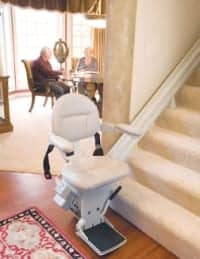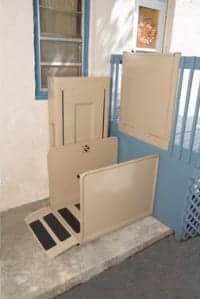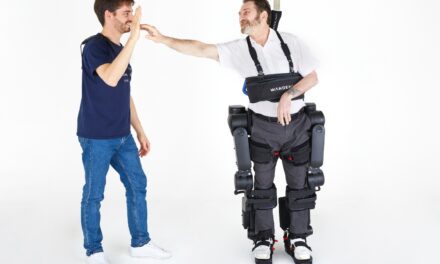
A stairlift fosters accessibility, and provides secure, comfortable transport.
Imagine, in an instant, almost all facets of your life change. How you eat, sleep, urinate, have sex, move, and even breathe has been altered. This is what can happen, abruptly and unexpectedly, when someone has a traumatic spinal cord injury. These bodily changes bring about a myriad of challenges that often require intensive training and assistive technologies for compensation. How do you hold a spoon if your hand can not grasp it? How do you roll over in bed if your abdominal muscles no longer contract? How do you move about in your community if your legs do not work? The deluge of questions are overwhelming to the newly injured person. These questions are answered daily by occupational therapists who work with people who have sustained new spinal cord injuries. Answers unfold over time in rehabilitation.
After training and assistive technologies are provided for the very basic activities of daily living (BADL) come the training and adapting for what is referred to as intermediate activities of daily living (IADL). IADL include activities such as homemaking, maneuvering around the community, and return-to-work tasks. The occupational therapist working with people with new injuries will systematically assess and adapt all IADL that are of interest to the individual. Returning to their prior living situation is usually at the top of the priority list. This can also be the most challenging evaluation and adaptation quest the therapist and person with the spinal cord injury face since the person’s mode of ambulation has usually changed significantly. A healthy body that ambulates independently is able to maneuver through relatively small spaces, turn tight corners, and jockey around varied obstacles, such as stairs and curbs, with ease. This new body, after a spinal cord injury, often requires a wheelchair for ambulation and therefore is challenged by many architectural barriers.
Working with people who have spinal cord injuries has provided me with many opportunities to assess work and home environments for new wheelchair users. I quickly learned to complete the initial assessment of a home or workplace alone. We become so used to entering and exiting our homes with ease that we often forget about that curb, gravel driveway, large threshold, or narrow doorway. Many of my patients truly believed they could get in the door only to find out when we arrived for the home evaluation that they could not. I always tell my students that the home evaluation does not start at the front door; it starts at the point of exit from the vehicle whether it is from a driveway, alley, or street. Here lies the first challenge. How does this new wheelchair user even get to their front door?
Below is a real case with problems listed as well as possible solutions. As with any problems, there are multiple solutions. Time, support, personal preference, and resources often determine which solution the individual chooses. Although this case involves someone with a spinal cord injury, it is not uncommon to see many of these same challenges when working with individuals with any type of decreased mobility.
CASE EXAMPLE
William is a 24-year-old man who sustained a T10 complete spinal cord injury after he jumped from a third-story window. He presents with no motor or sensory function below the level of injury (belly button). He plans to return home with his parents who live in a two-story house. William relies on a wheelchair for all functional mobility in and out of the home.
The following is a list of architectural barriers that needed to be addressed prior to William’s safe return home. Possible solutions that were recommended are also included.
BARRIERS

A vertical platform lift provides a sturdy solution for assisted access to a porch or deck.
- Driveway is gravel, there are two steps from the driveway to a short, cemented walkway, and then five more steps up to a wood porch that is only 3 feet deep.
- Front doorway is 29 inches wide (his wheelchair’s overall width is 31 inches).
- All bedrooms are on the second level of the home (only access is a flight of stairs).
- There is only a half bath on the main level.
- The second floor bathroom has a tub/shower with sliding glass doors and a low toilet.
- There are several throw rugs throughout the home.
- There are no grab bars in the bathrooms.
POSSIBLE SOLUTIONS TO BARRIERS
- Cement driveway for safe propulsion of wheelchair.
- Ramp first two steps with ADA-approved slope (there is enough room for this). This could be achieved by having a wood or cement ramp built, or by using a modular aluminum ramp.
- Extend porch so it is 5 feet deep and level with the threshold of the front doorway.
- Obtain a vertical platform lift to safely get to porch level.
- Reduce the wheelchair’s camber angle to decrease overall width of chair or widen doorway, and/or use offset hinges to make the front door accessible.
- Obtain a stairlift to get up to the second floor.*
- Remove sliding glass doors on tub and replace with a shower curtain.
- Obtain a tub bench for bathing.
- Install a handrail in the bathtub for safety.
- Install a handheld shower head for water access.
- Remove all throw rugs to increase safety during transfers and ease of wheelchair maneuvers.
- Obtain an elevated toilet seat for safe toilet transfers.
- Several solutions for lack of handrail next to toilet:
- Install handrail next to toilet.
- Install safety frame on toilet.
- Install a tension pole next to toilet.
- Obtain an elevated toilet seat with built-in grab bars.
*If you choose to obtain a stairlift, you will need a secondary wheelchair on the second level of the home (this secondary wheelchair may be obtained through a wheelchair recycling program at a low cost).
End result: After intense training was completed and assistive technologies were implemented, William returned home independent with all BADL and IADL from a wheelchair level.
It is important to note that this case involved someone who had the potential and motivation to be independent. Often a new wheelchair user, regardless of diagnosis, will need a caregiver to assist with BADL and IADL. A myriad of physical, emotional, and mental issues may necessitate the assistance of a caregiver. The occupational therapist must always consider accommodating a caregiver in the home environment. Creative assistive technologies may be taken into consideration when the client requires assist. Overhead track systems can be mounted anywhere in a home to provide total assist with any transfer, whether it be bed, bath, or toilet. PVC pipe shower commode chairs with track systems are another option for dependent tub and toilet transfers. A sling lift or easy pivot transfer aid can be used for dependent toilet and bed transfers. If the client is not dependent with the transfer and the caregiver is safe and independent assisting with the transfer, space must be considered during the home evaluation. The caregiver must be able to perform proper body mechanics during the transfer. Correct simulation of the home environment during training is paramount. It is well understood that transfer of skills in any motor-learning task is best achieved when the practice situation is most similar to the actual situation.
It is also important to note that his case gives an example of the bare necessities needed to achieve independence in one particular home. There are many further accommodations that would make a home much more user-friendly for a wheelchair user. Lowering countertops, clearing away lower cabinets under sinks, lowering upper cabinets, extending faucet handles, using lever-type handles, removing carpeting and installing hard flooring, removing thresholds, installing elevators, installing accessible decks to go outside, removing any excess furniture, installing raisers on bed and table legs, and remodeling a bathroom for a wheel-in shower are just a few more accommodations that could be considered when looking at the needs of a particular individual.

To read more on this topic, visit “An Accessible Address ,” “How to Evaluate Bath Equipment,” and “A User-Friendly Home.”
Unfortunately, funding is usually the strongest determinant for home modifications. Such home modifications for wheelchair accessibility are rarely covered by government or private insurers. The Department of Vocational Rehabilitation may assist with mobility devices that help the individual get out of their home to return to work or school. Workers’ compensation and some state-funded auto insurance policies cover home modifications as well. Most people, however, do not fall into the categories listed above. There are some great county programs that provide assistance to children or the elderly, but again, the majority of spinal cord injuries, for example, occur during young adulthood. Occupational therapists often recommend recycling programs for wheelchairs and bathroom equipment that is not covered by insurance. Individuals are also encouraged to use their ties to the community for assistance such as church groups and county-run programs. Fund-raisers are often recommended to offset the cost of modifying a home and purchasing needed assistive equipment.
Home modification can present an overwhelming challenge for anyone who has compromised mobility. With the support of therapists, equipment providers, the community, family, and friends, the outcome can be positive and provide a springboard to a new life with a new body.
Deborah Bebeau, MS, OTR, is an instructor at the University of Wisconsin-Madison’s Occupational Therapy Program. For more information, contact .





